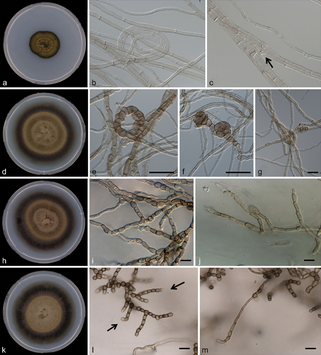|
by Cliff Bueno de Mesquita and Lara Vimercati Dothideomycetes is the largest and most diverse class of fungi in the phylum Ascomycota, with 19,000 species currently described. Species within the Dothideomycetes class range from plant pathogens, to saprotrophs to some that exist as the fungal partner in the lichen symbiosis to others that live on rocks. Interestingly, we have found Dothideomycetes in some of the most extreme environments on Earth. A taxon from the Dothideomycetes class was one of the taxa that responded to our water and water + nutrient experiment in hyper-arid soils collected from ~5000 meters elevation on Volcán Llullaillaco in the Atacama Desert in Chile. In this experiment, soils in Petri dishes placed in a freeze-thaw chamber were given water or water + nutrients on three separate occasions.  Figure 1. Dothideomycetes cultures and microscopy photos. a–c Rachicladosporium monterosium. a Colony appearance. b–c Hyphae septate, subhyaline to pale brown. d–g Rachicladosporium paucitum d Colony appearance. e–g Meristematic development of hypae, pale brown. h–j Rachicladosporium inconspicuum. From Egidi et al. 2013 Fungi within the Dothideomycete class significantly increased with multiple water additions in soil microcosms that were amended with organic carbon and nutrients. Dothideomycetes are known to be highly resistant to a number of extreme environmental conditions by developing avoidance strategies (Selbmann et al. 2015). For example, they can tolerate oligotrophy, repeated freeze-thaw stress (Onofri et al. 2007, 2008), radiation and dehydration (Onofri et al. 2012) by producing extracellular polymeric substances (EPS), melanin and compatible solutes. Many genera can form deeply melanized meristematic colonies and produce extracellular polysaccharides to ameliorate UV and osmotic stresses (Selbmann et al. 2005). Their unique colony morphology helps minimize exposure to external stressors by decreasing their surface to volume ratio and appear to have optimized a slow but persistent growth strategy for extremely cold and barren habitats (Ruibal et al. 2009). They are characterized by simple life cycles that can be completed during short periods of time when favorable conditions prevail (Selbmann et al. 2015). Oligotrophy of the extreme environments where they are found and the high metabolic costs to synthetize compounds related to stress resistance account for their slow growth velocity (Selbmann et al. 2014) and help explaining why the relative abundance of this taxon increases significantly only after the second and third water additions to the +WN treatments in this experiment, but not the initial additions.
References: Egidi, E., de Hoog, G.S., Isola, D., Onofri, S., Quaedvlieg, W., Vries, M.D., Verkley, G.J., Stielow, J.B., Zucconi, L., & Selbmann, L. (2013). Phylogeny and taxonomy of meristematic rock-inhabiting black fungi in the Dothideomycetes based on multi-locus phylogenies. Fungal Diversity, 65, 127-165. Onofri S, Barreca D, Selbmann L, Isola D, Rabbow E, Horneck G, de Vera JPP, Hatton J, Zucconi L (2008) Resistance of Antarctic black fungi and cryptoendolithic communities to simulated space and Mars conditions. Stud Mycol 61:99–109 Onofri S, de la Torre R, de Vera JP, Ott S, Zucconi L, Selbmann L, Scalzi G, Venkateswaran K, Rabbow E, Horneck G (2012) Survival of rock-colonizing organisms after 1.5 years in outer space. Astrobiology 12:508–516 Onofri S, Selbmann L, de Hoog GS, Grube M, Barreca D, Ruisi S, Zucconi L (2007) Evolution and adaptation of fungi at the boundaries of life. Adv Space Res 40:1657–1664 Ruibal C, Gueidan C, Selbmann L, Gorbushina AA, Crous PW, Groenewald JZ, Muggia L, Grube M, Isola D, Schoch CL, Staley JT, Lutzoni F, de Hoog GS (2009) Phylogeny of rock inhabiting fungi related to Dothideomycetes. Stud Mycol 64:123–133 Selbmann L, de Hoog GS, Mazzaglia A, Friedmann EI, Onofri S (2005) Fungi at the edge of life: cryptoendolithic black fungi from Antarctic deserts. Stud Mycol 51:1–32 Selbmann, L., de Hoog, G.S., Zucconi, L., Isola, D. and Onofri, S., 2014. Black yeasts in cold habitats. In Cold-adapted Yeasts (pp. 173-189). Springer, Berlin, Heidelberg. Selbmann, L., Zucconi, L., Isola, D. and Onofri, S., 2015. Rock black fungi: excellence in the extremes, from the Antarctic to space. Current genetics, 61(3), pp.335-345
0 Comments
Leave a Reply. |
AuthorVarious lab members contribute to the MoM Blog Archives
October 2023
Categories |

 RSS Feed
RSS Feed
